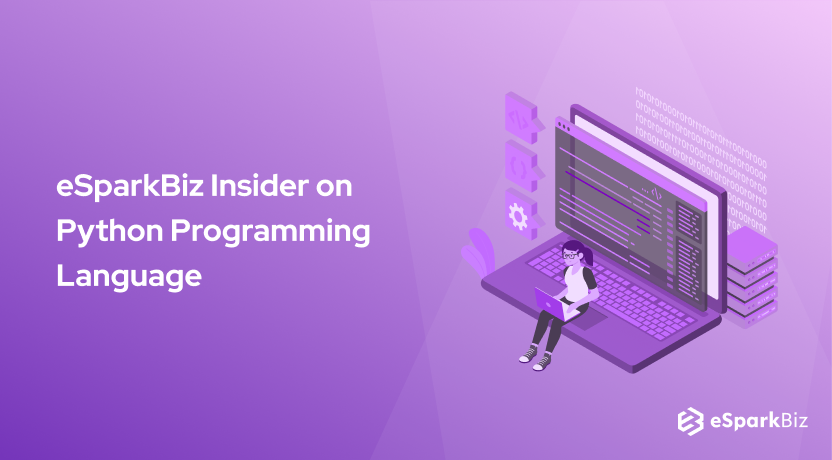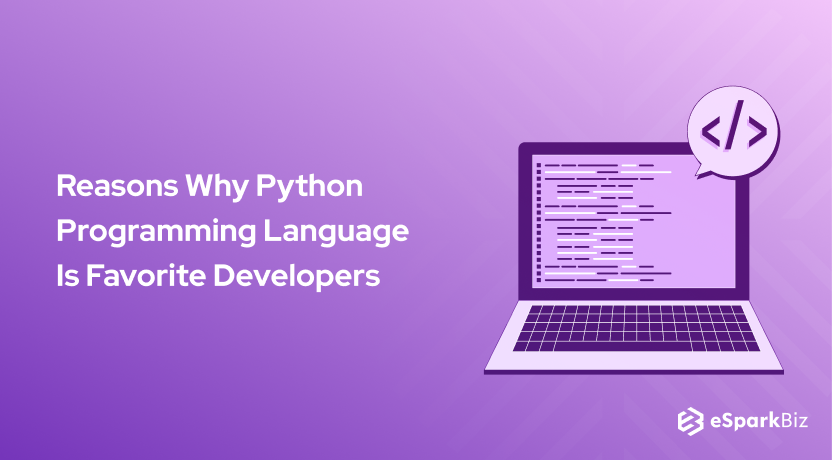In the world of programming, Python is a popular, interpreted, object-oriented, multi-purpose, and high-level programming language that can be used for just about anything. Today, we will discuss Is Python The Future of programming language?
It has marked its space and is soaring in popularity as it is widely accepted and among the top five programming languages across the globe. That’s why there is a lot of demand for Noteworthy Python Web Development Company and businesses that hire python developers.
Since its inception, Python has emerged as a first-class citizen in the world of programming, because of the feature it offers. Its simplistic, concise and modular approach has grabbed a lot of attention, right from its birth.
Python is one of the most popular and in-demand programming languages, our savvy developers have shared their views and practical experience in this article, Let’s explore the Future of Python and the promises it holds for the future.
Why Is Python So Popular?
Let’s shed some light on the main reason behind Why Python Is So Popular in the world of programming.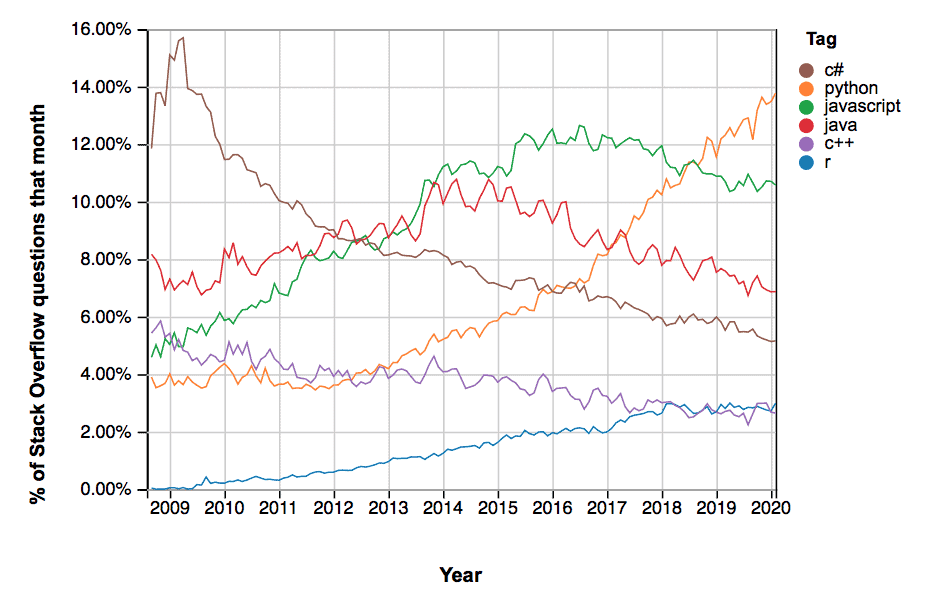
It had ample of time to mature and obtain a far-reaching and supportive community. That’s why Python For Software Development is a great choice.
Its versions have been evolved and upgraded with time. From version 1.0, it reached Version 3.8.1 and is right now one of the trending programming languages in 2024.
Beginner-Friendly
Python’s easy-to-learn, friendly, and spontaneous syntax makes it a transcendent language to master for beginners. Python has an effortless to follow syntax and therefore more understandable. One can readily apprehend what the code is deemed to do just by looking at it.
Versatile
Python is supreme for any purpose and developers have made a package for everything. You can ascertain a package for almost everything:
- NumPy, to crunch numbers, vectors, and matrices
- SciPy, for computations for tech and engineering
- Pandas, for diving deep into data manipulation and analysis
- Scikit-Learn, for AI-related tasks
Pseudo-Code
Python has a very simplistic and minimalistic feature that can tackle common programming tasks and its pseudo-code nature enables one to meditate on the resolution to the query and not the language.
Open Source
It is also an excellent example of FLOSS (Free/Libré and Open Source Software) that allows one to freely distribute copies of the software, read its source code, modify and make changes to it.
Anything imaginable can be succeeded with generously available open-source packages in Python.
Benefits of Python
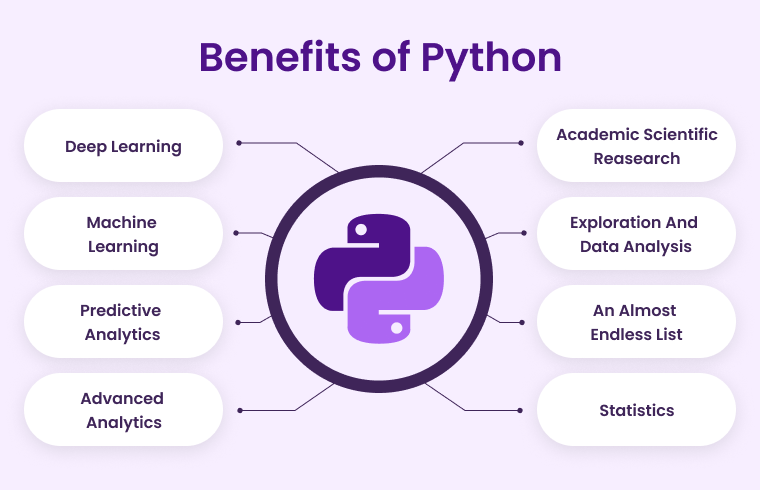
Free
Since Python is an open-source programming language, it is free and available to all for use. Its codes can be employed by anyone across the globe, over the internet. This feature makes Python ideal for businesses with budget limitations i.e. startups.
Front-End & Back-End
Being a general-purpose language and not a specific purpose language, Python can be adopted for both front-end and back-end development. However, Python is not as front-end friendly as it is for the back-end.
Cross-Platform Development
Python is one of the widely used major programming languages that are available for all cross-platform operating systems including Windows, Mac, Linux, etc which makes building applications with it all the more convenient.
This can even be used in the Kivy platform to create games for desktop and web applications.
Strong Community
The Python programming language has an eternally-thriving, global and influential community with over millions of software developers who communicate online and offline via thousands of virtual and physical places.
The community is dedicated to the development of Python and its third-party libraries. Python is evolving all the time as a more refined, more agile, and efficient way of acknowledging the hurdles of today and tomorrow.
Plethora Of Tools
The python programming language package has an enormous assortment of pre-written code and standard library that subdues the demand for applying effort for writing code or functions, boosting the overall usability and functioning of python as a programming tool.
The list of Python tools includes Tkinter (a GUI development tool), file formats, built-in functions, custom python interpreters, internet protocol and support, modules, etc.
Less Coding
Python has a really simplistic syntax by nature. A logic that may require 7 lines in a C++ language, can be done in merely 3 lines in Python. For more information, you can analyze the Python vs C++ comparison.
Having less coding means fewer area requirements and shorter time. This is well acknowledged by coders. Software that demands less time to code employs fewer resources and more succinct time and therefore, aids in cost cut and yields more profits.
Flaws In Python
Speed

Python is snail-paced. On average, it takes about 2–10 times longer to accomplish a task with Python. The reason behind its slow pace is being dynamically typed which implies that it demands a lot of memory usage and loads of computing time.
Moreover, Python can only perform one task at a time. In contrast, your average web browser can operate a dozen disparate threads concurrently.
Scope
Python was incipiently dynamically scoped, which means that in order to assess an expression, a compiler first investigates the current block and all the calling functions.
The dilemma here is that every expression requires time-consuming testing in every potential context. And therefore, most improved programming languages practice static scoping.
Lambdas

Python may be flexible; however, the practice of Lambdas is rather limited. It can only be expressions in Python, and not statements.
Whereas, variable declarations and statements are always statements. This denotes that Lambdas cannot be used for them. This differentiation in expressions and statements is dogmatic and doesn’t transpire in other languages.
Mobile Development
Python package – Kivy is designed exclusively for mobile development. Although Python wasn’t invented for mobiles, it can still deliver adequate outcomes for primary tasks.
However, the best decision is to employ a language that was formulated exclusively for mobile app development like React Native, Flutter, and Cordova. So, the Future of Python seems bright.
Runtime Errors
A Python script isn’t pre-compiled. It manually compiles every time you perform it, so any coding error reveals itself during runtime, which drives to unsatisfactory execution, time loss, and boundless testing.
This makes it novice-friendly as testing prepares them. But, for experienced developers, debugging a complicated program in Python makes them go circuitous and hence, a lot of run-time errors.
Applications Of Python
AI
The disruptive and futuristic AI is governed by Python. It helps in subduing the struggles of the human brain. From speech recognition to data analysis, Python has fueled AI’s unparalleled success.
Machine Learning
Machine learning has turned impossible into possible. For instance, you can now discover with Machine Learning, aids & resolutions if an image is a bike or car. It has grown to be an interminable domain today and adds profoundly to the tomorrow of python.
Big Data
The powerful performing libraries of Python are boosting the growth of big data technology. It adds remarkably in the approach of large data handling in computer clusters. Unquestionably, this guarantees a triumphant prospect of python.
Web Development
Web frameworks essentially assist in designing the server-side code that operates on the server. With the application of web frameworks, it has served in strengthening common back-end logic. One may employ either of the frameworks to develop web applications.
Flask has fewer components, more modest and more adaptable, while Django has more components, a precise style to trade with databases.
Data Visualization
Python is also desirable for data manipulation and returned tasks. The anticipated scope of Python is sunny as it helps in the interpretation of a substantial volume of data through its powerful-performance libraries and tools.
Matplotlib is one of the most prevalent Python libraries for data visualization. It’s effortless to start with it and also different libraries rely on it. Also, there are various libraries that can be adopted for data analysis.
Networking
Python is shining bright and has a sunny scope in the future in the world of Networking. The examples and applications of Python are proof of that.
Python programming language is utilized to read, write, and configure routers and switches and implement other networking & automation duties in a cost-efficient and protected manner.
This easy integration with High Tech stack like AI, ML and Big Data avails opportunities for premium Python Development Company to experiment and offer clients with appealing as well as futuristic solutions that will help them boost client’s business growth to new horizons.
Factors That Drive The Growth Of Python
Python is an infinite-purpose language, be it web development, mobile app development, or data science. There is an abrupt surge in Python’s usage. That’s why people ask Is Python The Future?
The app development market appears to have been “pythonized.” Let’s explore some reasons why Python is ruling today and tomorrow of technology.
So, for knowing What Is the Future of Python Language, firstly analyze the factors that drive the growth of python.
First Choice Language
Firstly, Python is free and hence the first-choice language for all. The huge assemblage of both future and select existing programmers wants to learn to crack a job. And Python is unmistakably in demand.
Since the count of data scientists and programmers is growing, hence Python’s recommendations for usage are also growing and it doesn’t intend to slow down.
Multi-Purpose and Versatile
Secondly, Python is amazingly all-purpose and versatile. It can be used for just about anything. Python is one of the unseen elements that we benefit from without knowing it and plays a small part in all of our lives that is powered by technology.
One of those invisible forces with a presence in our mobile devices, web searches, and gaming (and beyond), such as the development of both desktop, web applications, and data science.
Also, the emergence of data science is a significant driver in the universality and acceptance of Python as the most loved programming language.
Machine Learning
According to IBM, Python is one of the most prevalent languages for Machine Learning.
Machine learning essentially aids in identifying patterns in any given data. An essential responsibility of any machine learning engineer is to extract, process, label, clear, arrange, and interpret data to produce intelligent algorithms.
And, since Python is straightforward to follow, it is capable to handle any issues related to data.
Python serves as an enormous, thoroughly-tested, and ready-to-employ language, which can do anything and everything no matter how challenging it is.
There are several Python packages for loading and fiddling with the data. Just write a code that would cement everything together. Effortlessly easy!
Tech Giants Using Python
There are countless sites that are constantly marshaling Python and its development frameworks to enhance their productivity and for efficient handling of their principal production domains. Some of the big players include:
NASA
NASA’s Workflow Automation System (WAS), takes its basis on Python. Apart from this, NASA adopted Python for its various open-source projects such as APOD, API, EVEREST, etc.
All the in-house systems, API’s, report generation, log analysis, A/Q, testing, etc., exercise Python.
YouTube
YouTube, a subsidiary of Google, employs Python for video streaming, obtaining authoritative data, managing templates of the website etc.
Walt Disney Feature Animation
Walt Disney uses Python as a scripting language for the majority of its animation-related tasks & production.
Nokia
Nokia tech powerhouse utilizes PyS60(Python for S60) and PyMaemo (Python for Maemo) for its S60(Symbian) and Maemo (Linux) software platforms.
Top Competitors Of Python
Python’s competitors also play a major role in deciding the destiny of the python programming language in the IT market and the world of programming. The top competitors of Python globally based on different indexes:
Tiobe Index
The Tiobe Index states that Python stands as the top five popular programming languages in popularity ratings after Java, C, C++, and C#. However, with the swelling demand, these rankings may change very soon.
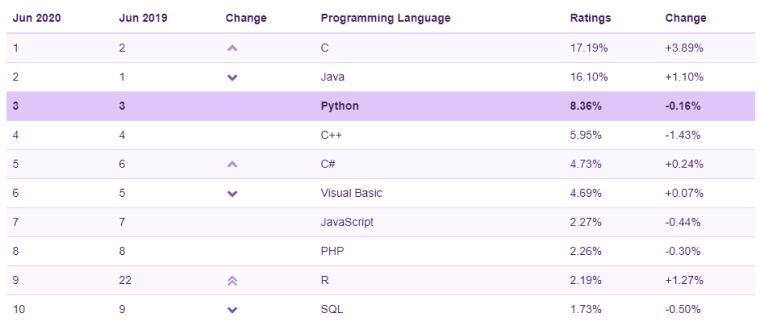
PYPL Index
As per the PYPL (Popularity of Programming Language) Index, Python seized the second spot in India and Germany, first position in the U.K, U.S.A, and France, giving neck-to-neck competition to Java.
According to Datanyze, Python is at the 5th rank from the list of top 31 frameworks and programming languages in India with a market share of 1.6 percent.
Is Python the Language Of Now or Forever?
Python is undisputedly a trendsetting language. It is the aptest language for anyone to start their programming journey because it is extremely easy to learn.
Python’s community and usage are definitely rising, hence the language is becoming more and more successful, but the reasons for the language’s prevalence lay in its provision for circumstantial development purposes.
The attribute that makes a programming language an asset is how it permits developers to communicate their concepts in a more simplistic style. Python ‘originates’ fewer lines of code than most of the other languages, however, it is still understandable and modifiable.
We are not exhibiting a war within the computer programming languages or attempting to drive the belief that Python’s head. We rather suppose it’s critical to realize that trends may change. So, knowing the Future of Python is important.
What Could Replace Python In Future?
- Rust offers an equivalent level of security like Python — You can not overwrite any variable inadvertently. However, it resolves the performance issue with the theory of ownership and borrowing.
- Go is a go-to language for beginners just like Python. It is simplistic and straightforward to manage the code. Moreover, Go developers are trending as the highest-paid programmers.
- Julia is the new kid on the block that is certainly competing for head-on with Python. It bridges the gap of large-scale technical computations, which would otherwise cover up using Python and C++ libraries. But now, you can adopt Julia instead of juggling between two languages.
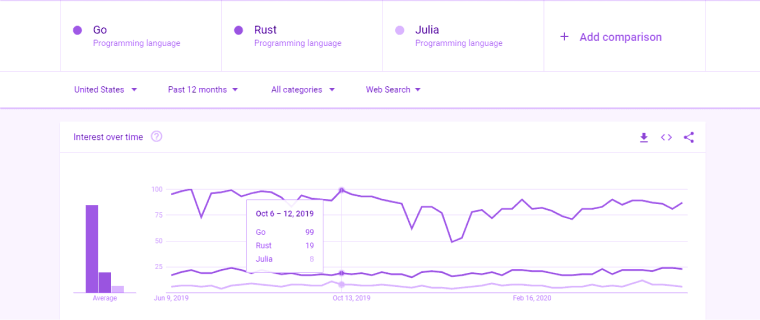
Even though Rust, Go, and Julia have emerged to cement the vulnerable cracks of Python, these languages are yet to incorporate disruptive techs like Artificial Intelligence. However, their growth trend is obvious: upwards despite a small market share.
Python is enjoying the throne of global fame at the moment, and it may definitely take a while for any new language to succeed. So, Is Python The Future question needs to be analyzed.
Nonetheless, Python’s performance issues seem to be serving as a red carpet for one of these languages to ultimately take its spot.
Read also: Python vs PHP: Which Is The Better Programming Language?
Career Opportunities With Python
Career breaks connected with Python have also grown significantly as its prevalence has risen by 40%. Numerous IT enterprises are hunting for experienced and skilled Python programmers.
This has demonstrated that Python positively has a promising future for the Python programmers.
Let’s dive into the list of Python programmers with their annual salary:
- Python Developer: 300,000k annually
- Software Engineer: 520,000k plus annually
- Senior Software Engineer: 900,000 plus annually
- Software Developer: 500,000 plus annually
- DevOps Engineer: 600,000 plus annually
- Data Scientist: 800,000 plus annually
Moreover, a recent job portal has revealed that above 40,000 Python jobs were queried in the USA.
Also, Stack Overflow data displayed that Python was the most visited job tag in the US and UK. One of the influential grounds for an extensive career possibility is the alliance of Python and Data Science.
Conclusion
The popularity of programming languages hints about where the digital world will go and also reminds us of how far we’ve come. And with Python, technological ease is at its peak.
It is easy and powerful, and has many built-in high-level data structures and utilizes dynamic typing and binding, making it an excellent choice for both scripting and application development. This fully-functional Python can do anything and better than the other languages, at comparable speeds.
We hope you had a great time reading this article and it proves to be of great use for any Python Developer. Thank You.!
-
Why Python Is The Future Of Networking?
Python is a programming language that can read, write, and configure routers. It can also perform the network function cost-effectively and there are many libraries for networking as well. So, Python is highly suitable.
-
What Is The Scope Of Python In Future?
Nowadays when cognitive technologies like AI, Machine Learning, Deep Learning, Big Data, etc. are in huge demand, Python can provide a great option for this in the future. So, in the future, Python will be used for such problems.
-
Is Learning Python Enhances Career Opportunities?
The simple answer to this question would be YES. Learning python can give you the best possible chance to have a great career. Many tech giants are now focusing on this language. So, career vise Python could be awesome.
-
Is Python Worth Learning In 2024?
After carrying out intensive research and surveys, experts are saying that Python will remain one of the topmost programming languages in the near future. So, it could be worth learning as well as mastering.

